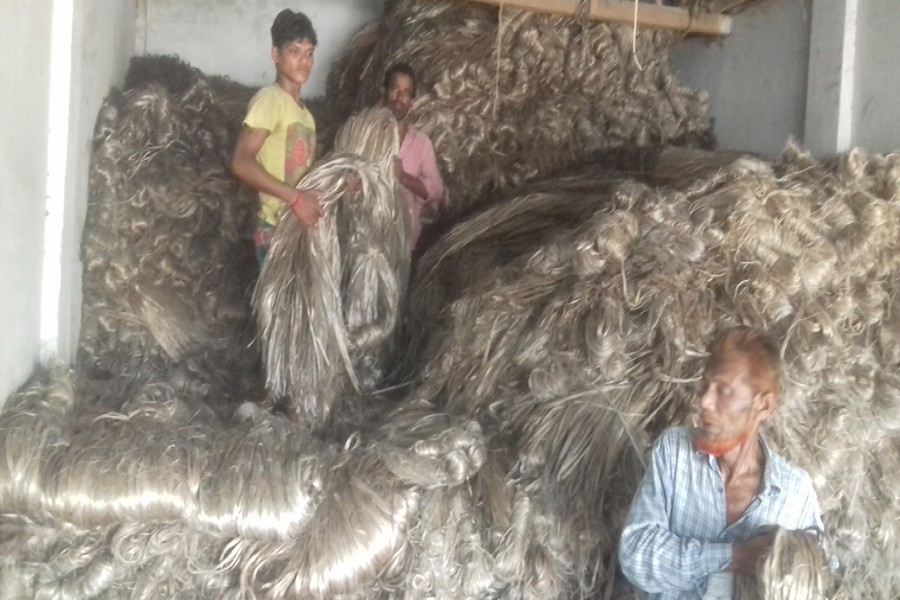Saif
Senior Member
- Joined
- Jan 24, 2024
- Messages
- 15,883
- Likes
- 7,986
- Nation

- Axis Group


Bumper jute yield raises hopes among Magura farmers
Bumper production of jute as well as its lucrative prices have come as hope raising factors for the farmers of the district this season. Satisfactory yield of jute has brought smiles to the face of the local growers making them optimistic about the lost glory of the crop, once called golden fibre,
Bumper jute yield raises hopes among Magura farmers
OUR CORRESPONDENT
Published :
Aug 10, 2025 08:11
Updated :
Aug 10, 2025 08:11

Newly-harvested jute is being traded in Notun Bazar of Magura tow Photo : FE Photo
Bumper production of jute as well as its lucrative prices have come as hope raising factors for the farmers of the district this season.
Satisfactory yield of jute has brought smiles to the face of the local growers making them optimistic about the lost glory of the crop, once called golden fibre, coming back rejuvenating agricultural landscape of the region.
There was a time when farmers used to cultivate jute on a large scale in the region finding big returns. But later farmers started losing interest in jute cultivation as switched to other crops for relatively increased profits. Rising production cost and downtrend in prices were the reasons behind their reluctance to cultivate the traditional crop.
Finally closure of the jute mills owned by Bangladesh Jute Mills Corporation disheartened the growers as well as traders.
But this year bumper production and lucrative prices of jute have raised hopes among the growers about its imminent prospects.
Newly harvested jute has already started to appear in the local markets. Bumper production and high prices have sent a wave of joy among the growers in the district.
Sources at the Department of Agricultural Extension (DAE), Magura said they had brought 34,370 hectares of land under jute cultivation in the district this season.
In the meantime, jute harvesting has started. Production may exceed the target which is 463,995 bales of jute.
Moshlemuddin, a farmer of Jagla village under Magura sadar upazila, said, "I brought two bighas of land under jute cultivation this season. I expected to get a yield of 20 maunds of jute. But my production will stand at 24 maunds."
"Moreover, due to adequate rainfall, I did not have to face extra irrigation cost for jute cultivation. For these I am enjoying a superb jute yield."
Another farmer Abu Saleh of Vitashair under Magura sadar upazila told the FE, "This year we are getting jute price at Tk3,500 per maund against Tk2,500 last year. This year I have brought my three bighas of land under jute cultivation. I have sold my produce at Tk120,000 while my production cost was only Tk35,000 that means my profit stands At Tk85,000. I am overwhelmed with such gains."
Farmer Golapdi Mollah of Belnagar village under Magura sadar upazila said, "We have got subsidy from the DAE for jute farming. Moreover, adequate rainfall has boosted our jute cultivation saving irrigation cost. At the same time present jute price is highly satisfactory to us. In this situation, we are optimistic that jute may bring back its glory if government extends subsidy for growers, ensures fair price and supply of quality seeds."
When contacted, DAE additional deputy director Bishnupada Shaha told the FE, "We have provided jute growers in the district with proper subsidy and training. Moreover, the weather was favorable for jute in the district this year. At the same time, farmers are getting high price for the crop . We hope the present situation will create a positive impact on jute cultivation in the coming year."
Agriculturist Khairul Abrar said jute is the country's glorious heritage. Moreover, jute planting has a positive impact on land. When jute is cultivated its leaves enhance fertility of the land falling down on it. Moreover, at present private jute mills hold huge employment in the country.
For several years jute mills are facing crunch of jute. So there is no alternative but to extend jute cultivation.
OUR CORRESPONDENT
Published :
Aug 10, 2025 08:11
Updated :
Aug 10, 2025 08:11
Newly-harvested jute is being traded in Notun Bazar of Magura tow Photo : FE Photo
Bumper production of jute as well as its lucrative prices have come as hope raising factors for the farmers of the district this season.
Satisfactory yield of jute has brought smiles to the face of the local growers making them optimistic about the lost glory of the crop, once called golden fibre, coming back rejuvenating agricultural landscape of the region.
There was a time when farmers used to cultivate jute on a large scale in the region finding big returns. But later farmers started losing interest in jute cultivation as switched to other crops for relatively increased profits. Rising production cost and downtrend in prices were the reasons behind their reluctance to cultivate the traditional crop.
Finally closure of the jute mills owned by Bangladesh Jute Mills Corporation disheartened the growers as well as traders.
But this year bumper production and lucrative prices of jute have raised hopes among the growers about its imminent prospects.
Newly harvested jute has already started to appear in the local markets. Bumper production and high prices have sent a wave of joy among the growers in the district.
Sources at the Department of Agricultural Extension (DAE), Magura said they had brought 34,370 hectares of land under jute cultivation in the district this season.
In the meantime, jute harvesting has started. Production may exceed the target which is 463,995 bales of jute.
Moshlemuddin, a farmer of Jagla village under Magura sadar upazila, said, "I brought two bighas of land under jute cultivation this season. I expected to get a yield of 20 maunds of jute. But my production will stand at 24 maunds."
"Moreover, due to adequate rainfall, I did not have to face extra irrigation cost for jute cultivation. For these I am enjoying a superb jute yield."
Another farmer Abu Saleh of Vitashair under Magura sadar upazila told the FE, "This year we are getting jute price at Tk3,500 per maund against Tk2,500 last year. This year I have brought my three bighas of land under jute cultivation. I have sold my produce at Tk120,000 while my production cost was only Tk35,000 that means my profit stands At Tk85,000. I am overwhelmed with such gains."
Farmer Golapdi Mollah of Belnagar village under Magura sadar upazila said, "We have got subsidy from the DAE for jute farming. Moreover, adequate rainfall has boosted our jute cultivation saving irrigation cost. At the same time present jute price is highly satisfactory to us. In this situation, we are optimistic that jute may bring back its glory if government extends subsidy for growers, ensures fair price and supply of quality seeds."
When contacted, DAE additional deputy director Bishnupada Shaha told the FE, "We have provided jute growers in the district with proper subsidy and training. Moreover, the weather was favorable for jute in the district this year. At the same time, farmers are getting high price for the crop . We hope the present situation will create a positive impact on jute cultivation in the coming year."
Agriculturist Khairul Abrar said jute is the country's glorious heritage. Moreover, jute planting has a positive impact on land. When jute is cultivated its leaves enhance fertility of the land falling down on it. Moreover, at present private jute mills hold huge employment in the country.
For several years jute mills are facing crunch of jute. So there is no alternative but to extend jute cultivation.






































